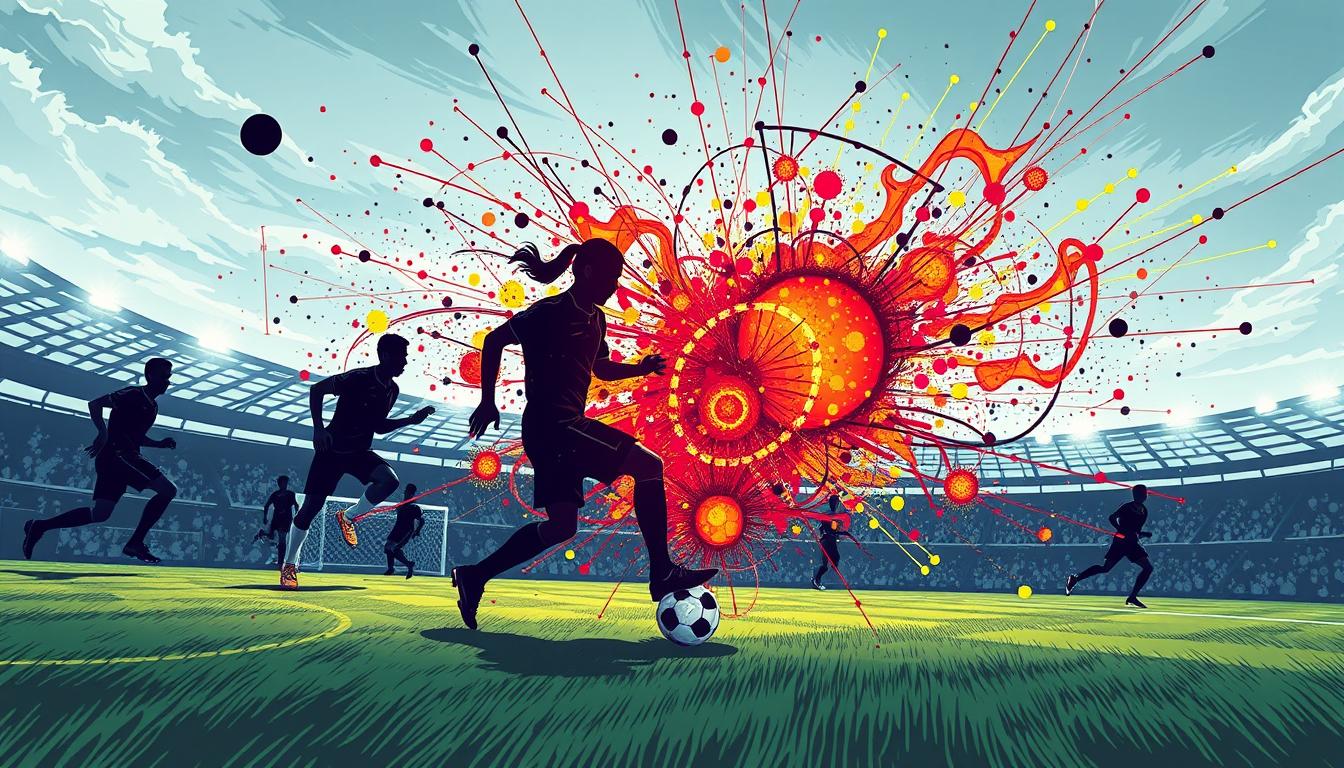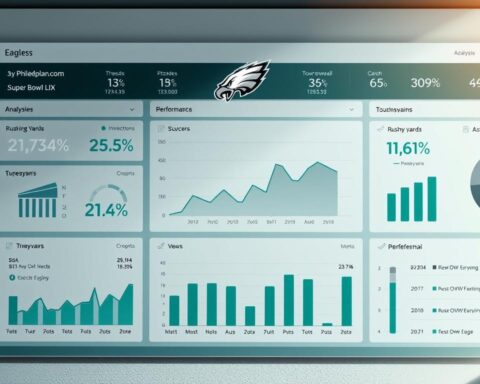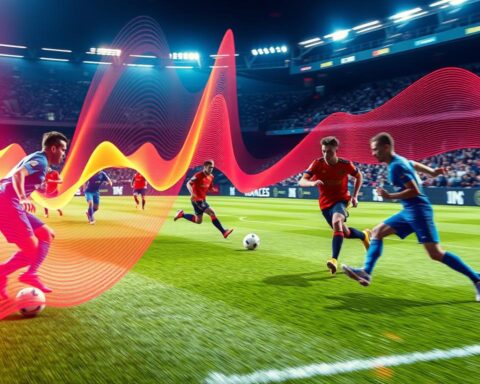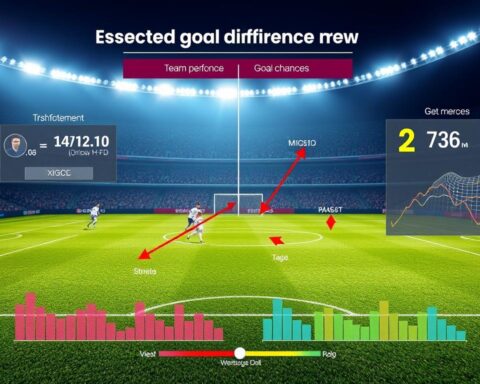Researchers conducted a groundbreaking study on 96 Champions League matches, involving 192 teams. They employed a logistic regression model, based on the Bernoulli distribution, to forecast match outcomes. The model considered three critical parameters: goals scored, home/away advantage, and average player ratings1. This pioneering soccer analytics approach is transforming the understanding of the game, potentially boosting a team’s mean expected finishing distribution by up to 35.6%2.
Monte Carlo simulations are revolutionizing soccer analytics, enabling the prediction of game scenarios and the making of data-driven decisions. These simulations leverage random sampling and probabilistic modeling. They offer profound insights into soccer strategy, aiding coaches, analysts, and fans in comprehending the factors influencing match outcomes.
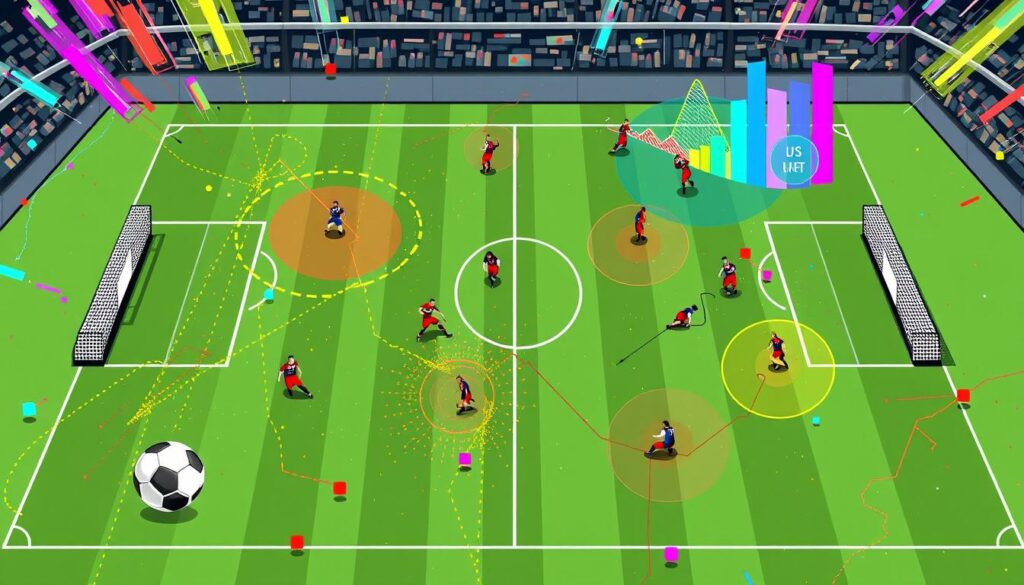
The study utilized Bayesian Inference to update probability hypotheses, integrating prior knowledge with new data. It also employed Markov Chain Monte Carlo (MCMC) approximations to address the limited dataset from the current Champions League campaign1. This advanced predictive modeling in soccer is supported by a variety of Python data science libraries, including NumPy, pandas, matplotlib, Seaborn, scikit-learn, and SciPy. Football analytics libraries like kloppy, floodlight, and statsbombpy also contribute to this cutting-edge approach3.
Real-world data from 760 English Premier League matches highlights the practical impact of these analytics techniques. Teams have seen an average improvement of 2.9 ranks out of 20 in their finishing position. This improvement is attributed to setting fluent objectives based on accurate league simulations and prior game knowledge2. As soccer analytics continues to evolve, the integration of Monte Carlo simulations, machine learning, and data visualization tools promises to unlock new levels of understanding and competitive advantage for teams globally.
Key Takeaways:
- Monte Carlo simulations use random sampling and probabilistic modeling to predict soccer game scenarios and inform data-driven decisions.
- A study analyzing 96 Champions League matches employed logistic regression and Bayesian Inference to predict match outcomes based on goals scored, home/away advantage, and player ratings.
- Teams can increase their mean expected finishing distribution by up to 35.6% and improve their league position by an average of 2.9 ranks using optimized tactics and fluent objectives based on accurate simulations.
- Python and R libraries for data science and football analytics, such as NumPy, pandas, kloppy, and statsbombpy, support the development of advanced predictive models in soccer.
- The integration of Monte Carlo simulations, machine learning, and data visualization tools is driving innovation and competitive advantage in the world of soccer analytics.
The Essence of Soccer Analytics and Predictive Modeling
In the professional sports domain, soccer has witnessed a notable increase in the application of analytics and predictive modeling to enhance competitive prowess. Analytics in soccer encompasses the collection, analysis, and interpretation of historical data to unveil critical insights, guiding strategic decision-making4. Through the utilization of advanced statistics and machine learning, teams can discern patterns, trends, and performance indicators, influencing their tactical strategies and elevating their success probabilities on the field4.
Understanding the Role of Data in Soccer Strategy
Data’s significance in contemporary soccer strategy is undeniable, with teams employing a diverse array of metrics to comprehend their performance and that of their adversaries. Metrics such as player attributes—passing accuracy, tackling efficiency, and assist rates—and team-level statistics—possession, shot conversion, and defensive solidity—are meticulously scrutinized5. Qualitative aspects, including team morale, player motivation, and cognitive functions, are also considered, providing a holistic perspective on the game’s complexities5.
The escalating importance of data in soccer is reflected in the substantial investments by clubs and leagues globally. Between 2010 and 2019, the English Premier League, Spanish La Liga, German Bundesliga, Italian Serie A, and French Ligue 1 witnessed a 429% increase in annual transfer fee investments, reaching a staggering €6,622 million5. This financial outlay signifies the conviction that data-driven strategies can yield substantial benefits both on and off the field.
From Historical Data to Predictive Insights
Historical data analysis offers valuable insights into past performances, yet the true strength of soccer analytics resides in its predictive capabilities. Advanced machine learning algorithms applied to extensive datasets enable analysts to develop sophisticated models that forecast future outcomes and identify risks and opportunities4. These predictive models consider a broad spectrum of variables, encompassing player-specific attributes, tactical considerations, and external factors such as weather and crowd dynamics5.
The evolution of soccer analytics over the past two decades has been remarkable, with a burgeoning research corpus exploring various analytical methodologies, including statistical analysis, machine learning, and mixed approaches45. From the inception of rudimentary data collection to the sophisticated techniques employed today, soccer analytics parallels the broader trajectory of data science. This journey is marked by significant milestones, such as John W. Tukey’s coinage of “bit” in 1947 and the establishment of the Data Mining and Knowledge Discovery Journal in 19976.
As soccer clubs and organizations continue to invest in data-driven strategies, the significance of predictive modeling in shaping soccer’s future is undeniable. By leveraging historical data analysis and advanced statistics, teams can gain a competitive edge, make informed decisions, and ultimately, achieve their objectives on the global stage.
Introducing the Monte Carlo Method in Soccer Predictions
In the realm of soccer analytics, the Monte Carlo method has emerged as a powerful tool for navigating the complex and dynamic nature of the sport. By leveraging probability and random sampling techniques, this approach enables analysts to predict match outcomes and inform strategic decision-making.
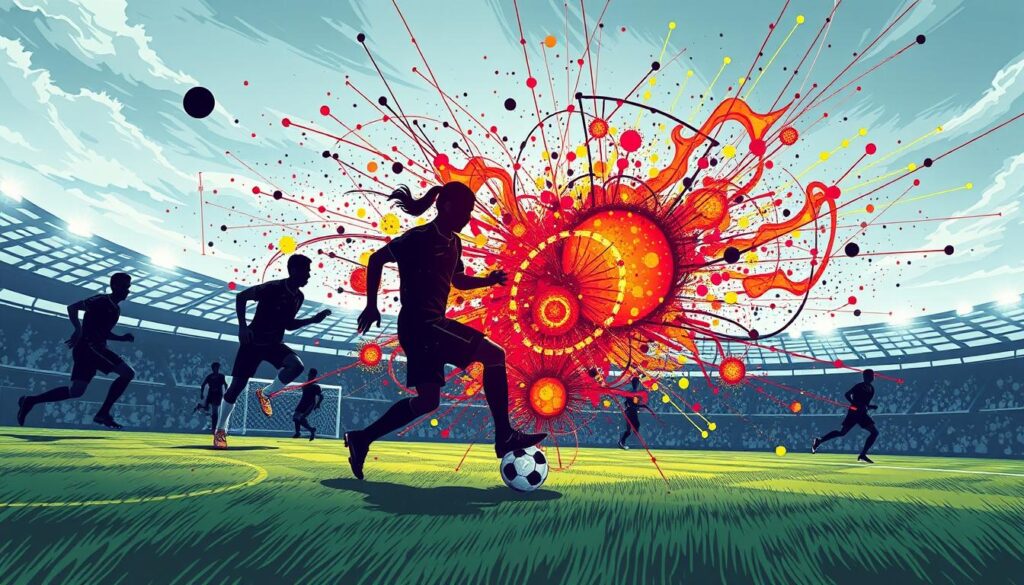
The Monte Carlo method assesses various factors influencing a soccer match, such as team strengths, player abilities, and tactical strategies, to generate a range of possible outcomes. This approach considers the inherent uncertainty and variability present in soccer matches, providing a more realistic and comprehensible understanding of the game7.
Navigating Complex Sports Systems with Probability
Soccer is a multifaceted sport with numerous variables interacting simultaneously, making it challenging to predict match outcomes with certainty. The Monte Carlo method addresses this complexity by incorporating probability distributions for key performance indicators, such as goal-scoring rates, possession percentages, and player performance metrics8.
By running thousands of simulations using these probability distributions, analysts can generate a distribution of result positions, considering probabilistic effects like lap time variation, varying pit stop durations, and full-course yellow (FCY) phases7. This approach provides a more nuanced understanding of the likelihood of different match scenarios, enabling coaches and strategists to make informed decisions.
The Role of Random Sampling in Outcome Predictions
Random sampling is a core component of the Monte Carlo method in soccer predictions. By randomly selecting values from the defined probability distributions, the simulations capture the inherent variability and uncertainty present in soccer matches.
This random sampling process allows for the exploration of a wide range of possible match trajectories, considering factors such as goal times, tactical changes, and player substitutions. By analyzing the results of these simulations, analysts can identify the most likely outcomes and assess the impact of different strategic decisions on match results.
The Monte Carlo method has proven to be a valuable tool in soccer analytics, providing a framework for understanding the complex dynamics of the sport and informing data-driven decision-making. As technology and data collection methods continue to advance, the application of this approach in soccer predictions is set to become even more sophisticated and impactful.
Note: The Monte Carlo method is a statistical simulation technique that relies on repeated random sampling to estimate the probability of different outcomes in complex systems, such as soccer matches.
Mastering Soccer Analytics: How Monte Carlo Simulations Predict Game Scenarios
In the realm of soccer analytics, Monte Carlo simulations have emerged as a powerful tool for predicting game scenarios and outcomes. These simulations leverage advanced mathematical modeling and data-driven insights, revolutionizing the understanding of the game’s complexities. They enable analysts, coaches, and fans to gain deeper insights into the beautiful game.
The Monte Carlo method involves simulating all remaining matches in a league using random inputs based on probabilities derived from previous performance. This yields one possible outcome9. By repeating this process multiple times, a distribution of outcomes is obtained, which can be interpreted as probabilities for teams to win the league9. Remarkably, Monte Carlo simulations can generate thousands of scenarios that closely predict the actual outcome with consistent distributions9.
The Elo rating system, a key component in soccer analytics, dynamically captures team strength over time, providing adaptive measures vital for analysis10. It’s important to note that initial Elo ratings can heavily influence long-term evaluations10. The system relies on historical match results, potentially overlooking nuanced factors like injuries or off-field issues10.
When it comes to predicting the outcomes of major tournaments like the Copa America 2024, predictive modeling techniques like Elo ratings and Monte Carlo simulations become instrumental10. By considering ternary outcomes (win, loss, draw) and refining the system for the tournament, analysts can generate more accurate predictions10.
The statistical variance calculated from a few thousand samples demonstrates the reliability of Monte Carlo simulations in predicting soccer game scenarios9.
While Monte Carlo methods are commonly associated with games, their practical application extends to business decisions, where they can quantify aspects influencing decision-making processes9. Techniques like Polynomial Chaos Expansion (PCE) can predict the likelihood of various outcomes within a soccer championship by considering variables such as team strength and players’ form. This offers a more efficient approach compared to computationally expensive methods like Markov Chain Monte Carlo (MCMC)11.
| Method | Advantages | Limitations |
|---|---|---|
| Monte Carlo Simulations | Generate thousands of scenarios, closely predict actual outcomes | Computationally intensive, requiring multiple iterations |
| Polynomial Chaos Expansion | More efficient than MCMC, requires fewer samples for accurate approximation | Limited to problems with a small number of random variables |
By mastering soccer analytics through the use of Monte Carlo simulations and other advanced techniques, analysts can uncover valuable insights. These insights shape strategies, inform decision-making, and enhance the overall understanding of the beautiful game.
Breaking Down the Monte Carlo Simulation Process
The Monte Carlo simulation process is a sophisticated tool for forecasting outcomes in complex systems, such as football games. It necessitates the identification of critical variables, the assignment of probability distributions, the execution of simulations, and the analysis of outcomes to ascertain the probability of varied scenarios12. This methodology has been extensively employed across diverse sectors, including finance, healthcare, and entertainment, to evaluate risk and enhance decision-making processes13.
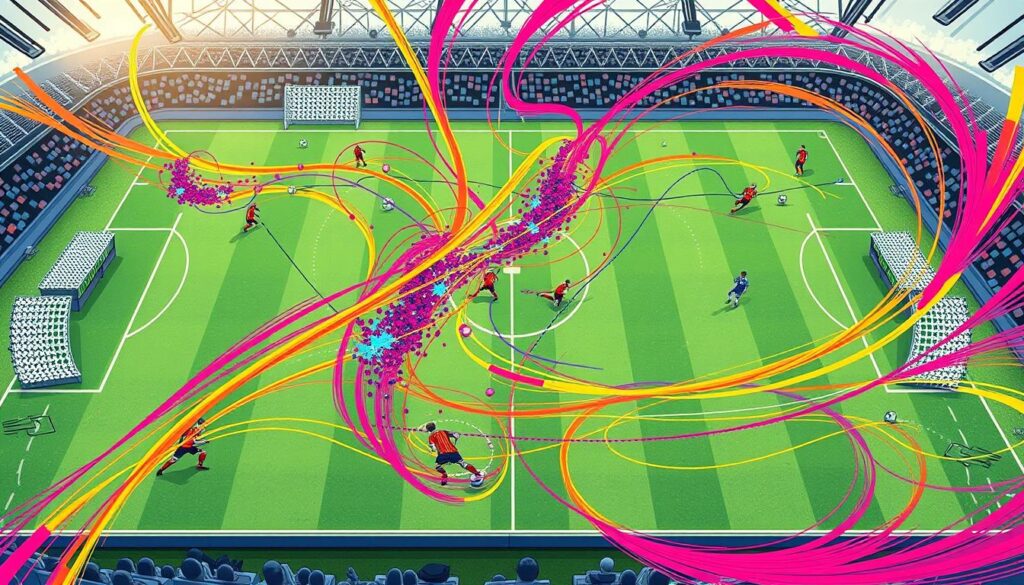
Step 1: Define the Variables
In constructing a Monte Carlo simulation model for football, the initial step involves the identification of the type of play and the factors influencing its outcome. Essential simulated attributes encompass the current down, field position, yards needed for a first down, the score, and player-specific metrics such as rushing or receiving yards12. The choice of probability distribution for inputs should mirror real-world observations of the system under simulation14.
Step 2: Assign Probability Distributions
Following the identification of variables, the subsequent step entails the assignment of probability distributions to each variable, grounded in historical data or expert insights. Logistic regression models are employed for decision-making in sports engines to forecast play types like pass or run, while multi-class classifier models predict the outcomes of plays, including pass completion, yardage gained, and turnovers12. The models are trained on historical data, yielding optimal coefficients for simulations12.
Step 3: Run Simulations
The process of running simulations involves generating random datasets and transforming deterministic models into stochastic ones14. Pseudo-random numbers, generated through mathematical functions, simulate randomness in Monte Carlo simulations14. Utilizing different seed values in generating random numbers facilitates the creation of varied sequences for reproducibility14. It is imperative to execute simulations a statistically significant number of times to validate results and minimize the likelihood of error14.
Step 4: Analyse the Results
The culmination of the process involves the analysis of aggregated results using statistical tools such as confidence intervals14. Monte Carlo simulation yields probabilistic results, graphical representations, sensitivity analysis, scenario analysis, and the capability to model correlations between input variables, providing a more nuanced understanding of possible outcomes13. The simulation methodology accounts for correlations between outcomes, such as from attempted passes to completed passes, passing yards, and rushing yards12.
| Industry | Application |
|---|---|
| Finance | Portfolio optimization, cash flow analysis, capital investments |
| Healthcare | Product pipeline analysis, cost estimation |
| Sports | Predicting game outcomes, optimizing betting strategies |
By dissecting the Monte Carlo simulation process into these four stages, analysts can effectively forecast outcomes in complex systems like football games, delivering invaluable insights for decision-making and strategy refinement.
Executing Monte Carlo Simulations in Soccer Analysis
Monte Carlo simulations have emerged as a powerful tool in soccer analysis, enabling analysts to predict game outcomes and assess the impact of various variables on team performance. By running thousands of simulations, analysts can derive a distribution of possible outcomes and gain valuable insights into the likelihood of specific scenarios occurring15.
Variables Impacting Soccer Game Outcomes
When executing Monte Carlo simulations in soccer analysis, several key variables must be considered. These variables include team offensive and defensive strengths, player performance, home advantage, recent form, and even weather conditions. Each variable is assigned a probability distribution based on historical data, which is then used to generate random values in each simulation run15.
For example, a team’s offensive strength can be modeled using a normal distribution curve with a specific mean and standard deviation, reflecting their average goals scored per match and the variability in their attacking performance15. Defensive capabilities can be represented by a distribution curve capturing the average goals conceded and the consistency of the team’s backline.
Probability Distributions in Soccer Scenarios
To accurately model soccer scenarios, analysts employ various probability distributions in their Monte Carlo simulations. These distributions, such as uniform, normal (Gaussian), lognormal, and Poisson, are chosen based on the nature of the variable being modeled15. For instance, the Poisson distribution is often used to model the number of goals scored in a match, as it effectively captures the discrete and rare nature of goal-scoring events.
By assigning appropriate probability distributions to each variable, analysts can generate realistic and diverse scenarios in each simulation run. This approach allows for a thorough exploration of possible outcomes, considering the inherent uncertainties and variabilities present in soccer matches.
| Variable | Distribution | Parameters |
|---|---|---|
| Team Offensive Strength | Normal | Mean: 1.5 goals, SD: 0.8 |
| Team Defensive Strength | Normal | Mean: 1.2 goals, SD: 0.6 |
| Home Advantage | Uniform | Min: 0.1, Max: 0.3 |
| Player Performance | Lognormal | Mean: 1.0, SD: 0.4 |
Through meticulous analysis, a recent study found that in a one-factor scenario where head-to-head history is considered an additional factor, with a weight of 0.3, a team’s win probability can increase to 76.9% due to head-to-head influence16. As the weight on the head-to-head factor is set to 1, the favored team’s probability rises even further to 81.25%, while their opponent’s probability decreases to 18.75%16. If the weight on the head-to-head factor is 0, the ELO-derived win probabilities remain unchanged16.
By harnessing the power of Monte Carlo simulations and incorporating relevant variables and probability distributions, soccer analysts can unlock valuable insights into game outcomes and make data-driven decisions to optimize team strategies and performance.
Practical Application: Simulating a Soccer Match
Monte Carlo simulations emerge as a potent instrument for forecasting soccer match outcomes, scrutinizing diverse elements that sway the game’s trajectory. Analysts must meticulously gauge each team’s offensive prowess and defensive resilience, drawing upon historical data and contemporary performance metrics12.
The realms of Python and R programming, augmented by libraries such as NumPy, Pandas, Scikit-learn, and SciPy, furnish the requisite apparatus for soccer analytics3. These tools empower analysts to dissect soccer event data, calibrate expected goals (xG) models, and conduct exhaustive analyses of player actions and strategic team maneuvers3.
Estimating Team A’s Offensive Strength
Analyzing a team’s offensive potency necessitates examination of metrics such as average goals scored, shot precision, and the performance of key players12. Employing machine learning paradigms, including logistic regression and multinomial logistic regression, analysts train predictive models on historical datasets. These models forecast scoring probabilities based on game state attributes like field position, down, and score disparity12.

Utilizing Python packages like ‘socceraction’ and ‘soccer_xg’, analysts can quantify the value of individual player contributions and refine expected goals models. This provides a nuanced understanding of a team’s offensive capabilities3.
Assessing Team B’s Defensive Capabilities
Assessing a team’s defensive prowess entails scrutinizing metrics such as average goals conceded, successful tackles, interceptions, and clearances. Binary classifier models are employed to forecast the probability of an opponent’s pass or run play, contingent upon game state attributes12.
R packages like ‘ggsoccer’ and ‘soccermatics’ facilitate the visualization and analysis of soccer tracking and event data. These tools unveil defensive performance patterns of a team3. By harnessing these resources, analysts can comprehensively appraise a team’s defensive fortitude and vulnerabilities3.
Employing the Monte Carlo method for simulating a soccer match entails delineating play types and outcomes on a play-by-play basis. This process considers factors such as pass attempts, yards gained, and the likelihood of fumbles or penalties12. By integrating machine learning models and leveraging the extensive array of soccer analytics libraries, analysts can generate simulations that are both accurate and informative. These simulations offer invaluable insights for strategic planning and betting endeavors.
Real-World Examples of Monte Carlo Simulations in Soccer
Monte Carlo simulations have emerged as a critical asset for soccer entities and analysts aiming to outmaneuver their competitors. These simulations, grounded in historical data and sophisticated statistical methodologies, unveil insights into the probabilities of match outcomes. They serve as a cornerstone for strategic planning, enabling teams to make informed decisions17.
Bayern Munich Example
The application of Monte Carlo simulations is exemplified by Bayern Munich’s Bundesliga prospects analysis. Analysts consider variables such as current performance, upcoming fixtures, and team-specific attributes in attack and defense. This approach forecasts Bayern Munich’s chances of success, leveraging Elo points, match venues, and other critical factors to refine predictions17.
Atletico Madrid Scenario
Atletico Madrid’s defensive strategy has been the subject of Monte Carlo simulations, aimed at assessing its impact on Champions League aspirations. By modeling the team’s distinctive playing style and contrasting it with opponents, analysts estimate the probability of Atletico Madrid’s progression through the tournament18.
Comparing Strategies
Monte Carlo simulations facilitate the evaluation of diverse strategies, promoting data-driven decision-making19. By simulating matches under different tactical frameworks, coaches can discern the most efficacious game plans. These simulations employ probability distributions, such as exponential and triangular distributions, to mimic real-world scenarios accurately18.
The table below presents a hypothetical comparison of strategies through Monte Carlo simulations:
| Strategy | Win Probability | Average Goals Scored | Average Goals Conceded |
|---|---|---|---|
| Aggressive Attacking | 65% | 2.8 | 1.2 |
| Balanced Approach | 55% | 1.9 | 0.8 |
| Defensive Focus | 45% | 1.2 | 0.5 |
As Monte Carlo simulations in soccer continue to advance, teams adept at utilizing this powerful tool will significantly enhance their predictive capabilities. This will lead to optimized strategies and, ultimately, success on the field19.
Benefits of Harnessing the Monte Carlo Method
The Monte Carlo method has revolutionized soccer analytics, introducing a more sophisticated and realistic predictive framework. It acknowledges the inherent uncertainty of soccer, providing a spectrum of probabilistic outcomes. This contrasts with deterministic predictions, which often fail to capture the full range of possibilities.
This method excels in simulating diverse scenarios, considering the vast array of variables influencing soccer matches. It incorporates extensive data, including player performances and tactical strategies, to generate probabilistic outcomes. For example, simulations favored the Sacramento Kings with a 61% chance against the Golden State Warriors20, and the Boston Celtics with a 56% chance against Miami20.
The Monte Carlo method’s provision of multiple outcomes empowers analysts, coaches, and bettors to make more informed decisions. It transcends the limitations of single, deterministic predictions, fostering a deeper understanding of various result probabilities. The model accurately forecasted the Los Angeles Lakers’ 4-2 victory over the Golden State Warriors20, demonstrating its predictive acumen.
Advantage of Probabilistic Outcomes Over Deterministic Predictions
The Monte Carlo method’s focus on probabilistic outcomes marks a significant shift from traditional deterministic predictions. It acknowledges soccer’s inherent unpredictability, providing a more nuanced and realistic perspective. Deterministic predictions, by contrast, often overlook the numerous variables and random events influencing match outcomes.
Probabilistic outcomes, generated by the Monte Carlo method, offer a more holistic understanding of result probabilities. This approach recognizes soccer as a complex interplay of factors, leading to a variety of possible outcomes. By providing a distribution of probabilities, it enables decision-makers to assess risk, plan strategies, and make more informed choices.
Identifying Key Performance Influencers
The Monte Carlo method’s ability to identify key influencers of team and player performance is another significant advantage. It analyzes the impact of different variables on simulation outcomes, providing insights into performance drivers. Analytics focused on expected possession value (EPV) by integrating shot zone efficiency data and team performance metrics20 underscore the importance of granular data in understanding performance drivers.
This method sheds light on the elements critical to determining match outcomes, from tactical decisions to individual player contributions. It enables coaches and analysts to make data-driven decisions and optimize strategies. Whether identifying effective formations, player combinations, or game plans, the Monte Carlo method is a powerful tool for performance analysis and improvement.
In the dynamic landscape of soccer analytics, the Monte Carlo method is a transformative force. It offers a sophisticated and realistic approach to predicting and understanding soccer. By leveraging probabilistic outcomes and identifying key performance influencers, it is revolutionizing the analysis, strategy, and engagement with the world’s most beloved sport.
Strategic Decision-Making Enhanced Through Monte Carlo Simulation
Monte Carlo simulations have emerged as a powerful tool for strategic decision-making in soccer. They harness probability and data-driven insights, providing coaches, strategists, and bettors with a competitive edge. This methodology is transformative, enabling more informed and strategic decision-making across various domains.
Application for Coaches and Team Strategists
Coaches and strategists benefit significantly from Monte Carlo simulations. These simulations allow for the testing of various tactical approaches, identifying the most effective strategies based on success likelihood. By analyzing multiple simulations, decision-makers can optimize their team’s performance on the field. Real-world datasets from 760 soccer matches have shown that optimized tactics can increase teams’ mean expected finishing distribution by up to 35.6%21. Further, data from 760 soccer games from the English Premier League’s past two seasons indicate that teams can improve their finishing positions by up to 2.9 ranks out of 2021.
Using Simulations for Smarter Betting Choices
Monte Carlo simulations also offer immense value for sports bettors aiming to enhance their wagering decisions. By understanding the probabilities of different outcomes and their associated risks and rewards, bettors can develop more strategic betting strategies. For example, a simulation model for the New York Yankees vs. Boston Red Sox matchup projected a 53.8% chance of the Yankees winning, corresponding to fair odds of -116. In contrast, the Red Sox were predicted to win with a 46.3% probability, resulting in fair odds of +11622. The initial market odds on bet365 for the Yankees were -135, and for the Red Sox were +114, closely aligning with the predictions, albeit with a note of caution regarding the role of luck22.
| Team | Win Probability | Fair Odds | Market Odds (bet365) |
|---|---|---|---|
| New York Yankees | 53.8% | -116 | -135 |
| Boston Red Sox | 46.3% | +116 | +114 |
By leveraging Monte Carlo simulations, both coaches and bettors can enhance their strategic decision-making, increasing their chances of success. As soccer evolves, the integration of advanced analytical techniques like Monte Carlo simulations will be instrumental in shaping its future.
Confronting Limitations and Cultivating Best Practices
Monte Carlo simulations have transformed soccer analytics, yet acknowledging limitations and adopting best practices is imperative for optimal outcomes. The simulations’ accuracy is contingent upon the quality of input data and the availability of computational resources23.
To transcend these hurdles, analysts must integrate their domain expertise with model-informed strategies. This necessitates the continuous update of data sources, validation of results against real-world outcomes, and model refinement. Such actions enable analysts to diminish the effects of data limitations and elevate the simulations’ reliability24.
Recognizing the Importance of Data Quality and Computational Resources
The efficacy of Monte Carlo simulations in soccer analytics is predicated on two critical elements: data quality and computational resources. Accurate simulations rely on high-quality data, encompassing player statistics, match histories, and tactical insights. Analysts must prioritize data collection, cleansing, and integration to ensure inputs are reliable and reflective of real-world scenarios.
Further, the availability of computational resources is instrumental in executing complex simulations. As variables and iterations escalate, so does the computational demand. Investing in robust computational infrastructure and optimizing algorithms is essential for analysts to manage large-scale simulations efficiently23.
Combining Expertise with Model-Informed Strategies
While Monte Carlo simulations offer valuable insights, they should not be relied upon exclusively. Analysts must amalgamate their domain expertise with model-informed strategies to formulate well-rounded decisions. This entails:
- Interpreting simulation results within the context of soccer knowledge and intuition
- Identifying biases or limitations in the models
- Incorporating qualitative factors not captured by simulations
By harmonizing data-driven insights with human expertise, analysts can effectively navigate the complexities of soccer analytics. The following table delineates best practices for amalgamating expertise with model-informed strategies:
| Best Practice | Description |
|---|---|
| Regular Model Validation | Compare simulation results with actual match outcomes to assess model accuracy and identify areas for improvement. |
| Iterative Refinement | Continuously update models based on new data, insights, and feedback from domain experts. |
| Collaborative Analysis | Foster collaboration between data analysts and soccer professionals to gain a holistic understanding of the game. |
“The art of soccer analytics lies in striking the perfect balance between data-driven insights and human expertise.” – A renowned soccer analyst
By acknowledging limitations, prioritizing data quality, and amalgamating expertise with model-informed strategies, analysts can unlock Monte Carlo simulations’ full potency in soccer analytics. This enables them to make more informed decisions, driving success on the pitch.
The Intricate Task of Simulating Soccer Games Play-by-Play
Simulating soccer games play-by-play necessitates a profound grasp of probability theory and statistical analysis. Probability theory imparts numerical values to delineate the likelihood of an event’s occurrence within the realm of simulation engineering25. The Monte Carlo simulation method, predicated on both probability and statistics, endeavors to forecast the outcomes of events, such as football match results, influenced by internal and external factors25.
From Kick-Off to Final Whistle: Modeling Each Segment of the Game
To accurately simulate a soccer game from kick-off to the final whistle, the simulation engine must incorporate various key decision points, such as the action classifier model and the yards attempted model12. Logistic regression models are employed in decision points within sports engines due to their capacity to map probability values between 0 and 1 to real numbers spanning from -∞ to ∞12. Multi-class classifier models, including multinomial logistic regression, are utilized to ascertain outcomes with multiple possibilities, akin to yards attempted and the outcome of a pass12.
Complex Modeling: Weighing Player-Specific and Tactical Variables
Simulating soccer games play-by-play entails modeling each segment of the game while considering player-specific variables, such as individual performance metrics and fatigue levels, alongside tactical variables, encompassing team formation and playing style. The simulation integrates team-specific models, tailored to capture the nuances of individual teams against specific opponents12. Various features, including current down, field position, yards required for a first down, and player-specific attributes, are instrumental in simulating each play within the football engine12.
Historical data serves as the foundation for training models and generating coefficients that optimize outcomes for the simulation engine12. The simulation methodology enables the modeling of correlations between play outcomes, such as attempted passes, completed passes, passing yards, and rushing yards12. By dissecting the game into smaller, more manageable segments, analysts can craft simulations that are more accurate and detailed, reflecting the dynamic nature of soccer.
Advanced Techniques in Soccer Simulations
In the realm of soccer analytics, professionals are now employing advanced methodologies to enhance predictive model accuracy and depth. The integration of machine learning algorithms and continuous model refinement enables analysts to develop sophisticated simulations. These simulations adapt to the dynamic nature of the sport, providing a more nuanced understanding of its intricacies.
Machine learning’s prowess in soccer simulations lies in its capacity to learn from extensive datasets. With FIFA Rankings encompassing 211 nations and 2,714 matches from 2000 onwards, excluding friendlies, machine learning algorithms have a vast reservoir of information to analyze16. This wealth of data facilitates more precise predictive modeling, revealing subtle patterns that traditional analysis might overlook.
Integrating Machine Learning for Finer Predictive Modeling
The incorporation of machine learning in soccer simulations has revolutionized predictive modeling. Analysts utilize libraries such as NumPy, pandas, matplotlib, Seaborn, scikit-learn, and SciPy for advanced data analysis and visualization in football analytics3. These tools empower professionals to uncover hidden insights, developing models that consider a broad spectrum of variables, including player performance and tactical decisions.
Machine learning algorithms also facilitate the analysis of soccer’s evolving strategies and player dynamics. By leveraging Python libraries like kloppy, floodlight, matplotsoccer, mplsoccer, PySport, ScraperFC, statsbombapi, statsbombpy, socceraction, soccer_xg, soccerdata, and tyrone_mings, analysts can explore the game’s complexities in depth3. These libraries support the creation of advanced models that account for player tracking, VAEP models, expected goals (xG) modeling, and player similarity assessments.
Enhancing Accuracy with Continuous Model Training
Ensuring the accuracy and relevance of soccer simulations necessitates continuous model training. Regular updates with the latest data and real-world feedback allow analysts to refine their predictions and adapt to changing circumstances. This ongoing process enables the incorporation of new variables, such as FIFA’s adoption of an adapted ELO system in 2018, which uses 600 instead of 400 and incorporates their own suite of factors and constants for rating updates16.
Continuous model training also allows analysts to fine-tune the weights assigned to various factors, such as head-to-head history and home-field advantage. For instance, assigning a weight of 0.3 to head-to-head results can significantly alter win probabilities, with Team A’s probability increasing to 76.9% and Team B’s decreasing to 23.1%16. By adjusting these weights based on the latest data and insights, professionals can create simulations that more accurately reflect the game’s true nature.
| Technique | Benefit |
|---|---|
| Machine Learning | Learns from vast amounts of data to uncover subtle patterns and insights |
| Python Libraries (e.g., kloppy, statsbombpy) | Enables advanced football analytics, such as player tracking and xG modeling |
| Continuous Model Training | Ensures simulations remain accurate and relevant by incorporating the latest data and feedback |
As soccer analytics continues to evolve, the importance of advanced techniques like machine learning and continuous model training will grow. By adopting these cutting-edge methodologies, analysts can develop simulations that offer deeper insights, aiding coaches, strategists, and fans in their understanding of the sport.
Incremental Improvements and Innovations in Soccer Predictions
The realm of soccer analytics is undergoing a profound metamorphosis, driven by incremental advancements and pioneering innovations. The exponential growth in computing capabilities has significantly enhanced the capacity for data analysis26. This development has facilitated the creation of more precise and adaptive predictive models.
Machine learning algorithms and AI are increasingly being employed in sports for diverse applications, including game activity analytics, talent identification, training, coaching, and fan/business-related aspects26. These advancements have not only elevated the precision of soccer predictions but have also unveiled novel avenues for real-time analytics and in-game betting strategies.
Real-Time Analytics: A Game Changer in Sports Betting
Real-time analytics has revolutionized the domain of sports betting. By harnessing live data streams and rapid simulation updates, bettors can now make more informed decisions during matches. This technological advancement has enabled a dynamic betting experience, where odds and probabilities are continuously updated based on the evolving game state.
The integration of machine learning algorithms, predominantly Artificial Neural Networks (ANNs), has gained prominence in sports analytics between 2006 and 201026. These sophisticated tools enable the processing of vast amounts of historical data, identifying patterns and trends that can be leveraged to predict future outcomes with greater precision.
The Future of Dynamic In-Game Betting Strategies
As the confluence of real-time analytics and machine learning continues to advance, the future of dynamic in-game betting strategies appears incredibly promising. Bettors will soon have access to sophisticated tools that adapt to the ebb and flow of the game, presenting new opportunities for strategic wagering.
“The immense possibility for AI to revolutionize sports betting is evident. By leveraging the power of real-time data and advanced algorithms, we can create truly immersive and intelligent betting experiences.”
Research elucidates how AI is employed in team sports for match outcome modeling, in-game tactical decisions, player performance, and managing injuries26. These applications not only benefit sports teams and coaches but also empower bettors with unprecedented insights and predictive capabilities.
As the world of soccer analytics continues to evolve, the future of sports betting is poised for a thrilling transformation. With incremental improvements and groundbreaking innovations driving the industry forward, enthusiasts and bettors alike can look forward to a new era of enhanced predictions and dynamic in-game experiences.
Case Studies: The Impact of Monte Carlo Simulations in Soccer
Monte Carlo simulations have emerged as a powerful tool in the world of soccer analytics, providing valuable insights into team performance and strategic decision-making. By analyzing historical match outcomes and running simulations, teams can uncover hidden patterns and make data-driven decisions that can significantly impact their success on the field.
Recent studies have highlighted the significant impact of Monte Carlo simulations in reducing player injury incidence and optimizing team selection strategies. In the 2021/22 season, the ‘Big Five’ European soccer leagues experienced £513 million in injury-related costs, a 29% increase from the previous season27. With injury rates during soccer matches varying from 10 to 60 incidents per 1000 playing hours, finding ways to minimize these risks is of utmost importance27.
Analyzing Historical Match Outcomes Through Simulations
By applying Monte Carlo simulations to historical match data, researchers have developed models that can effectively predict match outcomes and player performance. One such study used data from 760 English Premier League games across two seasons to evaluate the model’s performance against a myopic Greedy strategy, commonly employed by managers27. The model achieved similar performance to greedy team selections while reducing player injury incidence by approximately 13% and the standard deviation in season-expected points by about 17%27.
Another study focused on predicting soccer match results in Serie A TIM using only descriptive match statistics collected during the first half, consisting of 166 matches24. Various classifiers, including neural networks and SVM, were tested for predicting match outcomes, with initial poor results due to dataset entropy24. By refining the models and focusing on accurately modeling 0-0 draws, researchers proposed the use of Hurdle models to improve predictive accuracy24.
Simulations Informing Tactical Adjustments During Matches
Monte Carlo simulations can also be leveraged to make tactical adjustments during live matches. By running simulations based on real-time data, coaches can assess the evolving probabilities of different outcomes and make informed decisions to gain a competitive edge. This approach can be invaluable in high-stakes situations, such as critical league matches or knockout tournaments.
To support such in-game decision-making, various Python and R libraries have been developed for football analytics3. These include libraries like kloppy for standardized tracking and event data, floodlight for sports data analysis, matplotsoccer for visualizing soccer event data, and statsbombapi for accessing StatsBomb data3. The socceraction library also enables the valuation of individual actions in soccer, including an implementation for Expected Threat (xT)3.
| Library | Language | Purpose |
|---|---|---|
| kloppy | Python | Standardized tracking and event data |
| floodlight | Python | Sports data analysis |
| matplotsoccer | Python | Visualizing soccer event data |
| statsbombapi | Python | Accessing StatsBomb data |
| socceraction | Python | Valuing individual actions in soccer |
As the field of soccer analytics continues to evolve, Monte Carlo simulations will undoubtedly play an increasingly critical role in shaping team strategies and decision-making processes. By harnessing the power of these simulations, teams can gain a competitive advantage, minimize player injury risks, and optimize their performance on the pitch.
Future of Monte Carlo Simulations in Soccer Analytics
The evolution of soccer analytics is imminent, with the advent of artificial intelligence and machine learning poised to transform strategy and decision-making. Monte Carlo simulations, a cornerstone in the analyst’s toolkit, are destined to play a vital role in this transformative era.
Integration with AI and Machine Learning
The fusion of Monte Carlo simulations with AI and machine learning heralds a new era of profound insight and predictive capability. By harnessing extensive historical data, these advanced systems refine their methodologies, unveiling concealed patterns that significantly enhance simulation accuracy28. As these technologies progress, we anticipate the development of more refined models, capable of adapting to real-world scenarios and delivering increasingly dependable forecasts.
Machine learning algorithms are instrumental in pinpointing the variables most critical to match outcomes, enabling analysts to concentrate their simulations on the most impactful factors25. This focused approach not only streamlines the simulation process but also yields more practical insights for coaches and strategists.
Real-Time Simulation for In-Game Decision-Making
The most promising development for Monte Carlo simulations in soccer lies in their capacity to influence real-time, in-game decision-making. By leveraging live match data and integrating it into sophisticated simulation models, coaches will soon have access to predictive insights that enable them to refine their strategies instantaneously.
Envision a scenario where a coach, confronted with a critical substitution decision, can consult a simulation that considers the game’s current state, player performance metrics, and historical data to forecast the most probable outcomes of various tactical maneuvers16. Such data-driven decision-making could confer a substantial competitive advantage, significantly impacting the outcome of high-stakes matches where every decision is critical.
| Technology | Impact on Soccer Analytics |
|---|---|
| Artificial Intelligence | Enhances accuracy of simulations and uncovers hidden patterns |
| Machine Learning | Identifies most influential variables and streamlines simulation process |
| Real-Time Simulation | Informs in-game decision-making and optimizes strategies |
As the future beckons, the synergy of Monte Carlo simulations with cutting-edge technologies is set to revolutionize soccer analytics. By embracing these powerful tools, teams will gain a deeper comprehension of the game, enabling them to make more informed decisions that propel them towards success on the pitch.
Incorporating Monte Carlo Simulations in Your Soccer Analysis Toolkit
The evolution of soccer analytics necessitates the integration of Monte Carlo simulations, a critical component for teams and analysts seeking a competitive advantage. These simulations harness the power of probability and statistics, enabling the exploration of diverse outcomes and the facilitation of informed decisions. This is pertinent both on and off the field.
From Theory to Practice: Building Your Own Simulation Model
The transition from theoretical concepts to practical application in simulation model development is formidable. Yet, with the appropriate methodology and tools, this journey can unveil profound insights. Initially, a thorough comprehension of Monte Carlo simulation fundamentals, encompassing probability distributions and random sampling29, is imperative. Proficiency in statistical methodologies, including regression analysis, logistic regression, and classification, is equally critical for your analytical toolkit29.
Prospective sports statisticians must prioritize the acquisition of advanced data management competencies, such as SQL, and remain abreast of the latest research and methodologies29. Resources like Hoopdata.com, basketballvalue.com, and apbr.org are invaluable for staying current with basketball analytics, which often translates to soccer analytics as well29.
Recent studies have illustrated the broad applicability of Monte Carlo simulations in sports analytics. These include forecasting injury distributions and player quality fluctuations in Australian Football24 and quantifying individual impact in T20 cricket through ball-by-ball data24. Such examples underscore the versatility and efficacy of simulation models in addressing complex issues across various sports.
Constructing a soccer simulation model necessitates not only technical acumen but also a profound grasp of the game’s intricacies. As Keith Woolner emphasizes, domain-specific knowledge, encompassing rule comprehension, player recruitment, evaluation processes, and industry terminology, is indispensable for success in sports statistics29. By merging your passion for soccer with analytical prowess, you can forge a potent tool that empowers your team to make strategic decisions and attain their objectives.
As you navigate the transition from theory to practice, remember that effective communication is as vital as technical proficiency. The ability to articulate your analyses and insights to non-technical stakeholders, such as coaches and players, can significantly influence the translation of your simulations into actionable strategies on the field29.
Conclusion
The integration of Monte Carlo simulations into soccer analytics heralds a transformative epoch, poised to redefine the dynamics of team, analyst, and fan understanding. With FIFA’s exhaustive catalog of 211 nations and a dataset of 2,714 matches from the top 61 ranked teams spanning 2000 to present, the imperative for advanced mathematical modeling and data-driven insights intensifies16. Bayesian Inference, a statistical methodology that updates hypothesis probabilities with additional evidence, emerges as a cornerstone in this evolution1.
Through the application of logistic regression, Bernoulli distribution, and Markov Chain Monte Carlo (MCMC) approximations, soccer analysts can craft predictive models that consider a myriad of factors influencing match outcomes1. These include the disparity in player or team ratings, historical head-to-head encounters, home field advantage, and others16. The success of plus-minus ratings in basketball, a metric employed in the NBA to adjust for teammate and opponent quality, serves as a paradigm for soccer analytics to enhance predictive modeling30.
The trajectory of soccer analytics, propelled by the adoption of advanced techniques like Monte Carlo simulations, positions those who embrace these innovations at a strategic vantage point. By merging expertise with model-driven strategies, coaches, strategists, and bettors can enhance their decision-making and performance. The trajectory of soccer analytics is inextricably linked with the integration of sophisticated mathematical models, machine learning, and real-time simulations. This synergy will empower teams to refine their tactics and strategies in response to the fluidity of game scenarios. As more entities invest in these data-driven methodologies, the sport is on the cusp of a new era characterized by strategic decision-making and performance optimization.
FAQ
What is the Monte Carlo method, and how does it apply to soccer analytics?
What are the key variables that influence the outcome of a soccer match?
How can soccer coaches and strategists benefit from using Monte Carlo simulations?
What are some real-world examples of Monte Carlo simulations being used in soccer?
What are the limitations of using Monte Carlo simulations in soccer analytics?
How can machine learning and AI enhance the accuracy of soccer simulations?
What does the future hold for Monte Carlo simulations in soccer analytics?
Source Links
- Using Bayesian Modeling to Predict The Champions League – https://towardsdatascience.com/using-bayesian-modeling-to-predict-the-champions-league-8ebb069006ba
- Optimising Long-Term Outcomes using Real-World Fluent Objectives: An Application to Football – https://www.ifaamas.org/Proceedings/aamas2021/pdfs/p196.pdf
- Edd Webster Football Analytics – https://github.com/eddwebster/football_analytics
- Sports Analytics algorithms for performance prediction – https://www.academia.edu/84853787/Sports_Analytics_algorithms_for_performance_prediction?uc-sb-sw=56029315
- The collection, analysis and exploitation of footballer attributes: A systematic review – https://content.iospress.com/articles/journal-of-sports-analytics/jsa200554
- Sport Informatics and Analytics – Pattern Recognition – https://sites.google.com/site/ucsportinformaticsandanalytics/pattern-recognition
- Virtual Strategy Engineer: Using Artificial Neural Networks for Making Race Strategy Decisions in Circuit Motorsport – https://www.mdpi.com/2076-3417/10/21/7805
- Distribution of Premier League Goals – https://medium.com/analytics-vidhya/distribution-of-premier-league-goals-855c909c6955
- Estimating value (4) – Monte Carlo methods and final thoughts – https://www.linkedin.com/pulse/estimating-value-4-monte-carlo-methods-final-dieter-verhofstadt?trk=read_related_article-card_title
- How Data Science Could Predict the Champion of Copa America 2024 – https://www.futsalua.org/en/column/406/predict-copa-america-champion-2024
- Bayes rarely went to Qatar 2022, as we had anticipated. Why is this happening? What can we learn? – https://www.linkedin.com/pulse/bayes-rarely-went-qatar-2022-we-had-anticipated-why-diego
- Modeling Football: Combining ML models and Monte Carlo simulations – https://medium.com/draftkings-engineering/modeling-football-combining-ml-models-and-monte-carlo-simulations-170fd58cbe11
- What is Monte Carlo Simulation? | Lumivero – https://lumivero.com/software-features/monte-carlo-simulation/
- Monte Carlo simulation tips & tricks | Analytica – https://analytica.com/blog/monte-carlo-simulation-tips-and-tricks/
- Monte Carlo Simulation in Excel – https://excel.tv/monte-carlo-simulation-excel-tutorial-download/
- Monte Carlo Simulation of 2022 FIFA World Cup – https://vegeorge94.medium.com/monte-carlo-simulation-of-2022-fifa-world-cup-fa9c08b9e652
- PDF – https://arxiv.org/pdf/2205.04173
- Chapter 6 Input Analysis | Simio and Simulation – Modeling, Analysis, Applications – 7th Edition – https://textbook.simio.com/SASMAA7/ch-input-analysis.html
- A Survey of Opponent Modeling in Adversarial Domains – https://dl.acm.org/doi/pdf/10.1613/jair.1.12889
- Unlocking NBA Strategies: How Shot Zone Data and Markov Chains Could Change Basketball Analysis – https://www.futsalua.org/en/column/339/nba-analysis-strategies
- Optimising Long-Term Outcomes using Real-World Fluent Objectives: An Application to Football – https://eprints.soton.ac.uk/449655/1/Football_Objectives_AAMAS_21.pdf
- An Intro to Quantitative Modeling for Sports Bettors (in Excel) – https://medium.com/@lloyddanzig/quantitative-sports-betting-6976e1ceaf0f
- PDF – https://services.math.duke.edu/~rtd/EOSP/EOSP2E.pdf
- PDF – https://mathsportinternational.com/MathSport2017BookOfAbstract.pdf
- The complementary nature of probability and statistics in simulation engineering – https://softwaresim.com/blog/the-complementary-nature-of-probability-and-statistics-in-simulation-engineering/
- Frontiers | Artificial Intelligence and Machine Learning in Sport Research: An Introduction for Non-data Scientists – https://www.frontiersin.org/journals/sports-and-active-living/articles/10.3389/fspor.2021.682287/full
- Microsoft Word – SSAC-Paper-193978-Camera-Ready – https://assets-global.website-files.com/5f1af76ed86d6771ad48324b/65c3e810172e3e17f1bd9fbf_The Strain of Success – A Predictive Model for Injury Risk Mitigation and Team Success in Soccer.pdf
- PDF – https://arxiv.org/pdf/1806.01930
- Preparing for a Career as a Sports Statistician: Two Interviews with People in the Field – https://stattrak.amstat.org/2012/08/01/sports-statistician/
- Hvattum_final.pdf – https://sciendo.com/downloadpdf/journals/ijcss/18/1/article-p1.pdf
